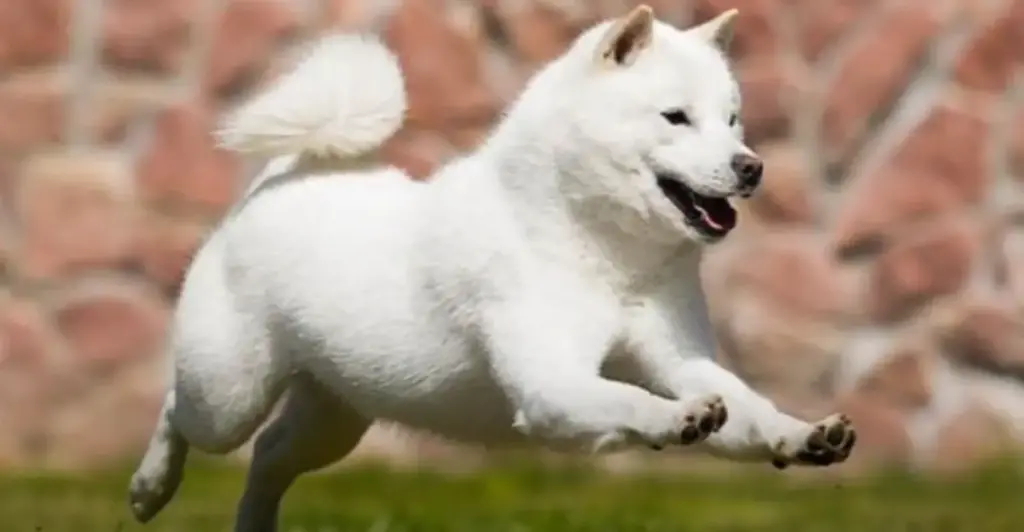In the stillness of the Japanese mountains, the Hokkaido dog’s spirited bark resonates, signaling the presence of game and the embodiment of a tradition as old as the snow-laden peaks.
You’ll find that the Hokkaido, a dog breed with a storied history and robust character, offers more than just companionship; it brings an ancestry steeped in the art of survival and hunting prowess.
As you explore the traits of this remarkable breed, you’ll discover how their fierce loyalty and keen intelligence make them exceptional pets for those who understand and respect their nature.
Yet, before you consider the Hokkaido as your next four-legged family member, it’s crucial to consider whether their energetic temperament and exercise needs align with your lifestyle.
Stay with me as we unpack the intricacies of caring for a dog that is as much a cultural icon as it is a testament to the art of breeding for purpose and resilience.
- Noise Level
- Energy
- Sociability
- Trainability
- Care
- Health
Overall
Summary
The Hokkaido breed is known for its moderate noise level, high energy, moderate sociability, moderate trainability, moderate care requirements, and good health.
Hokkaido: Traits, Temperament, and Care Guide
The Hokkaido dog, characterized by its robust physique and alert demeanor, epitomizes the qualities sought in a versatile hunting companion. Its traits, temperament, and care requirements necessitate a comprehensive understanding of its characteristics.
Originating from Japan, these hunting dogs have been integral to the Ainu people, renowned for their loyalty, courage, and intelligence. A medium-sized, muscular breed with a dense, double coat, they come in various colors and require regular grooming.
Early socialization and training are paramount for their development into well-behaved companions. While generally hearty, vigilance is necessary for health issues like hip dysplasia.
You must consider their independent nature, exercise needs, and rarity outside Japan to ensure they fit well into your life and receive the care they deserve.
Exploring the Characteristics of the Hokkaido
While exploring the characteristics of the Hokkaido dog, it’s important to note that their muscular build and dense coat are a direct result of adaptation to the harsh climates of their native island. These medium-sized canines exhibit a balance of strength and agility, complemented by a dual coat that provides insulation. Their lineage, deeply rooted in the Jomon period, has imbued them with traits that resonate with those seeking a sentient and faithful companion.
| Trait | Description |
|---|---|
| Size | Medium, robust, muscular |
| Coat | Dense undercoat, harsh outer coat |
| Intelligence | Highly intelligent and trainable |
| Health Concerns | Prone to hip dysplasia, retinal atrophy |
| Social Media | Growing presence, showcases personality |
Analyzing the Hokkaido’s attributes reveals a breed that is not only easy to train but also possesses an innate intelligence, making them an exemplary choice for those aspiring to integrate an affectionate and perceptive pet into their family.
Hokkaido: A Comprehensive Profile and Guide
As you explore the Hokkaido dog’s origins, you’ll find its genetic lineage largely untouched by external canine populations and rooted deeply in Japan’s Jomon period.
This breed’s physical attributes, including the robust musculature and acute sensory faculties, reflect adaptations to the rigorous demands of its historical environment.
Considering their temperament, the Hokkaido’s innate understanding and fidelity underscore the necessity of early socialization to harness their potential as both companions and adept hunters.
Everything You Need to Know
Delving into the world of the Hokkaido dog, one discovers a breed with a storied past, marked by its official recognition as a Japanese natural monument over eight decades ago. As you seek to understand this venerable member of the dog breeds, consider its defining traits:
- Ancient Origins: The Hokkaido’s lineage traces back to its vital role alongside the indigenous Ainu people, embodying resilience and fidelity.
- Distinctive Physique: A medium-sized, muscular frame equipped with a robust coat, designed to withstand harsh climates.
- Intelligent Temperament: Known for their acute intelligence, the Hokkaido exhibits a loyal and courageous demeanor, necessitating consistent training and adequate exercise needs to maintain balance and well-being.
Hokkaido’s rich heritage and loyal nature are paramount in your quest for a companion who echoes a sense of belonging.
Discovering the Temperament
To fully appreciate the Hokkaido dog as a potential pet, it’s crucial to understand its temperament, which is characterized by profound loyalty and a fearless disposition. The fidelity they exhibit towards their owners is emblematic of their desire to form strong, enduring bonds. These dogs are innately courageous, their bravery rendering them exceptional watchdogs.
With an intellect that facilitates rapid learning, Hokkaido dogs are adept at various dog sports, their activity level necessitating regular engagement. However, their independence can sometimes manifest as stubbornness, making early socialization and training imperative. Positive reinforcement techniques are essential in cultivating cooperation and ensuring adaptation to their human family.
A potential owner must recognize these temperament traits to provide an environment where a Hokkaido dog can thrive.

Hokkaido: Is It a Good Fit for Families?
You may find the Hokkaido dog’s loyalty and intelligence highly compatible with family dynamics, particularly if you value a pet that can integrate seamlessly into your household.
However, their independent streak and substantial exercise requirements necessitate a family lifestyle accommodating regular, active engagement.
Additionally, while the Hokkaido’s unique appearance and versatility are attractive, potential owners must be prepared for the grooming commitment and the challenge of locating a reputable breeder, given their rarity outside Japan.
Assessing Hokkaido’s Compatibility with Families and Kids
When considering the Hokkaido dog as a family pet, it’s important to weigh its loyal and intelligent nature against its need for exercise and independent temperament. With a penchant for forming strong bonds, these dogs can integrate well into the family unit, especially when socialized from a young age to help prevent behavioral issues.
Consider these points:
- Strong Bonds: Hokkaido dogs are known for their loyalty, which can translate into excellent companionship for children and adults alike.
- Exercise Requirements: They need regular exercise, which must be factored into a family’s lifestyle to ensure the dog’s well-being.
- Grooming Needs: Preparedness for grooming is essential, as the breed’s coat requires regular maintenance.
Understanding these aspects is crucial for ensuring that a Hokkaido dog fits harmoniously into your family.
Hokkaido’s Climate Versatility
One remarkable aspect of the Hokkaido dog is its extraordinary ability to adapt to the varying climates of its native region, from frigid winters to humid summers. This breed’s thick double coat, consisting of a dense undercoat and a more rugged outer coat, provides exceptional insulation against the cold, safeguarding it as temperatures plummet.
As the seasons shift, the Hokkaido dog’s coat adapts, shedding excess fur to maintain comfort and regulate body temperature effectively in warmth. This inherent resilience allows them to navigate snowy landscapes and endure heat with proper care easily.
Such adaptive traits reflect the Hokkaido’s evolutionary history, marked by survival across 24 distinct seasonal shifts, fortifying their place as versatile and robust companions.
Hokkaido Obedience Essentials
As you consider the Hokkaido’s need for early socialization, recognize that the breed’s temperament hinges on exposure to diverse environments and stimuli during puppyhood.
Your leadership style should be consistently firm yet adaptable, acknowledging the breed’s independent streak which can manifest as occasional stubbornness.
Incorporating positive reinforcement techniques leverages the Hokkaido’s intelligence and loyalty, enhancing their ability to excel in obedience and various canine sports.
Effective Training Strategies
To effectively train a Hokkaido dog, it’s essential to employ positive reinforcement techniques that motivate and captivate these intelligent animals during obedience sessions. Your approach should be analytical, focusing on the nuances of their behavior to tailor training strategies accordingly.
| Strategy | Benefit |
|---|---|
| Positive Reinforcement | Encourages eagerness and attention during training |
| Mental Stimulation | Prevents boredom and enhances cognitive engagement |
| Consistency & Patience | Fosters trust and understanding, prevents matting |
Incorporate early socialization to cultivate a well-mannered companion comfortable in diverse scenarios. Align training with their innate abilities, such as hunting and guarding, to optimize their potential. Remember, effective training strategies are about understanding and shaping the Hokkaido’s instincts into desirable behaviors, ensuring a harmonious bond between you and your loyal friend.
Exercise and Grooming Needs
Ensuring a Hokkaido dog receives ample daily exercise and regular grooming is imperative for its physical and mental well-being. These spirited canines thrive on activities such as walking, running, and hiking, which cater to their exercise needs and provide essential mental stimulation. Integrating these activities into your daily routine fosters a profound bond, rendering you an integral part of their pack.
Equally important is maintaining their double coat through weekly brushing and bathing as needed. This regimen and routine nail trimming and ear cleaning uphold their grooming needs, promoting optimal health and hygiene.
A balanced diet, high-quality dog food and a proper feeding schedule, is crucial. Before welcoming a Hokkaido into your life, weigh the commitment their exercise and grooming needs entail, ensuring you’re prepared to meet these demands.

Health Considerations
When considering a Hokkaido dog, it’s imperative to acknowledge its susceptibility to certain hereditary conditions, such as hip dysplasia and progressive retinal atrophy. You must ensure its longevity and vitality through consistent veterinary care, a nutritious diet, and tailored exercise regimens.
Selecting a Hokkaido from a breeder who rigorously tests for these health issues can significantly influence the dog’s health trajectory and contribute to achieving its potential lifespan of 12 to 15 years.
Common Health Issues and Lifespan
While Hokkaido dogs boast a robust constitution, they’re susceptible to health conditions such as hip dysplasia and progressive retinal atrophy, necessitating vigilant health management practices. Committing to regular veterinary checkups, a balanced diet, and proper exercise would be best to foster their well-being. These proactive measures are pivotal in mitigating common health problems and elongating the breed’s lifespan, typically 12 to 15 years.
Engaging with a reputable breeder who screens for genetic health issues is paramount. Such due diligence ensures you adopt a dog with the best potential for a long, healthy life.
Alternatives for Hokkaido: Loyal and Hardy Medium-Sized Breeds
For those who adore the Hokkaido’s loyalty and hardiness, these medium-sized breeds offer a similar combination of dedication and resilience.
| Similar Dogs | Short Description |
|---|---|
| Shiba Inu | A small Japanese breed known for its independence and fox-like appearance. |
| Akita | A larger Japanese breed renowned for its dignity, courage, and loyalty. |
| Jindo | A Korean breed known for its loyalty, intelligence, and elegant appearance. |
| Karelian Bear Dog | A Finnish breed, known for its bravery and skills in hunting large game. |
Is Hokkaido the Right Dog for You?
Before you consider bringing a Hokkaido dog into your home, evaluating whether its loyal yet independent nature aligns with your lifestyle and expectations is crucial. This breed’s intelligence and adaptability suggest a capacity for forming profound bonds, yet it requires an owner who appreciates autonomy in their canine companion.
You must be prepared to meet their exercise demands. These energetic dogs thrive in activities like dog sports, which also help mitigate potential health problems through fitness and engagement.
Given their rarity outside Japan, grooming and sourcing a Hokkaido from a reputable breeder are challenging. Careful deliberation is imperative to ensure that the Hokkaido’s unique attributes harmonize with your aspiration for a deep, reciprocal relationship with your pet.
Conclusion
In the tapestry of canine lineage, the Hokkaido dog emerges as a robust thread, woven with vigor and loyalty. Your journey through this guide has unfurled the rich hues of its heritage and temperament, revealing a breed not merely to be owned, but to be understood and respected.
As a prospective guardian, weigh the tapestry’s texture—its demands and delights—against the fabric of your life, ensuring a harmonious blend that honors this noble hunter’s storied legacy.
